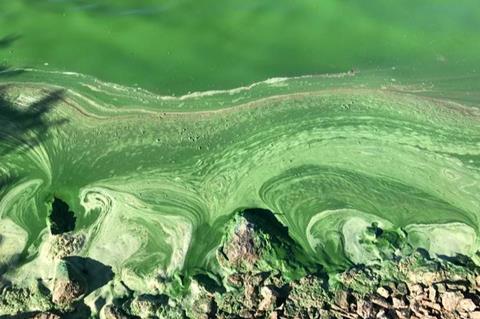As climate change warms the Earth, higher-latitude regions will be at greater risk for toxins produced by algal blooms, according to new research led by Carnegie’s Anna Michalak, Julian Merder, and Gang Zhao.

Their findings, published in Nature Water, identify water temperatures of 20 to 25 degrees Celsius (68 to 77 degrees Fahrenheit) as being at the greatest risk for developing dangerous levels of a common algae-produced toxin called microcystin.
Harmful algal blooms result when bodies of water get overloaded with nitrogen and phosphorus runoff from agriculture and other human activities. These excess nutrients can allow blue-green algae populations to grow at an out-of-control rate.
Serious health hazard
Some blue-green algal species produce a toxin called microcystin, which can pose a serious health hazard to people and the environment, as well as pose economic risks for fishing and tourism. Microcystin affects liver function and can cause death in wild and domestic animals, including humans in rare instances. It is also classified as a potential carcinogen in cases of chronic exposure.
“In 2014 an algal bloom in Lake Erie led to high levels of microcystin in water intakes, and residents in Ohio and Ontario were instructed not to drink tap water due to risk of exposure,” Merder cautioned.
PROMOTED: AMI has teamed up with QIAGEN to help you get the highest yields from your DNA Extractions. Get your free guide here.
Merder, Michalak, and their colleagues - Carnegie’s Gang Zhao, University of Kansas’s Ted Harris, and Dimitrios Stasinopoulos and Robert Rigby of the University of Greenwich - analyzed samples taken from 2,804 U.S. lakes between 2007 and 2017. They assessed how water temperature affects the occurrence and concentration of microcystin as part of an effort to better understand the risks to water quality posed by climate change.
Sentinels of climate change
Michalak’s lab has taken a leading role in understanding the intersection of climate change and water quality impairments for more than a decade. Previous work has shown that lakes worldwide are already experiencing more severe algal blooms and that nutrient pollution is being exacerbated by changes in rainfall patterns.
“Lakes are sentinels of climate change,” Michalak said. “They hold the vast majority, 87 percent, of the liquid freshwater on the Earth’s surface, and the warming and precipitation shifts associated with climate change pose some of the greatest threats to water quality around the world and to the health of aquatic ecosystems.”
The surface temperatures of lakes have already been warming at 0.34 degrees Celsius (0.61 degrees Fahrenheit) per decade and Merder and Michalak set out to determine what this, as well as future warming, would mean in terms of risk for elevated toxin concentrations.
“The abundance of blue-green algae is predicted to increase due to climate change as they outcompete other species,” Merder explained. “But previous field studies came to various conclusions about what this means for microcystin concentrations.”
Toxins and water temperature
To inform land and water management strategies, it was important to quantitatively tie toxin levels to water temperature, which Merder and Michalak were able to accomplish through their extensive analysis of lake water samples, revealing that water temperatures in the 20 to 25 degrees Celsius (68 to 77 degrees Fahrenheit) range were most dangerous in terms of elevated microcystin concentrations. They also found that the impact of temperature is amplified when nutrient concentrations are high.
By incorporating information from climate models, they were able to demonstrate that areas most susceptible to high toxin concentrations will continue to move northward. In some areas, the relative risk of exceeding water quality guidelines will increase by up to 50 percent in the coming decades. Additionally, they showed that toxin hazards will decrease in a small number of regions further south, as water temperatures begin to exceed those associated with the highest risk.
“These findings should help demonstrate the serious risk to safe water for drinking, fishing, recreation, and other societal needs in many parts of the United States and the urgency for developing management strategies to prepare,” Michalak concluded. “When we think about water sustainability in the context of global change, we need to focus on the quality of the water as much as we focus on the amount of water.”







No comments yet